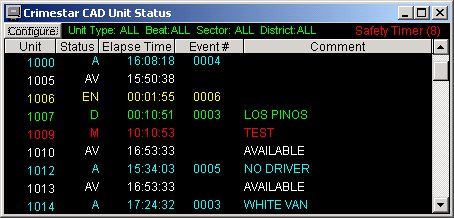 Law Enforcement Software
Law Enforcement Software
 Law Enforcement Software
Law Enforcement Software
The Unit status monitor is designed to show the dispatcher what field resources (i.e. Units) are in service at the time and what activity, if any, they are assigned. Units are displayed in alphanumeric order from top to bottom. Each unit is displayed in a specific color based on the status of that unit. The color used for each status is configurable by the user at each CAD workstation. Where multiple CAD workstations are in operation, it is possible to have status colors configured differently at each station, however, in the interest of consistency, training and operational ease of use, it is not recommended. An elapsed time is also shown for each unit. The elapsed time displayed represents the amount of time that a particular unit has been in the same status. Elapsed time is represented as Hours, Minutes and Seconds (HH:MM:SS). The maximum elapsed time that can be displayed for a unit is 99 hours, 59 Minutes and 59 Seconds. Beyond this limit Hours will be represented as “**”. Safety Timers are used to alert the dispatcher when a unit has been in the same status for an excessive period of time. When a safety timer expires the line for that unit will begin to flash, using a custom/user defined background color as a means to alert the dispatcher. The dispatcher may then want to contact the unit to confirm the safety or status of that unit. The dispatcher can then reset or cancel the safety timer as desired.
To activate a unit status monitor click the Units command button on the CAD control panel

While the status monitor shows the most current unit status transaction, it is important to realize that all status transactions are saved to a database table where they can be later examined. It is the collection of unit status transactions over time that serve to document the movement and activity of a particular field unit and record important comment data throughout the duration of that units shift or assignment.
A dispatch workstation may have multiple status monitors active at the same time with each status monitor showing different information, based on the configuration setting for the monitor window. So for example, a dispatcher may have one unit status monitor that displays only police units and another unit status monitor window that displays only fire units. When multiple status monitor windows are to be used, it is recommended that the computer workstation utilize dual or multiple display monitors with an extended desktop so that enough physical space is available to display all windows.